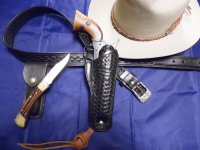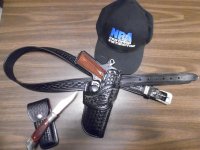Not found in the sticky here about leather holster linings, is the following:
Any maker of any size uses clicker dies to make gunleather. That's because they're very cheap and it takes very little volume to justify the increase in speed (that is, savings on labor) including edge treatments and eliminating 'what happened there?' thoughts.
That means that the die used to make the unlined holster, that 50 years ago was the standard, is used to make the lined holster. So one can't use the same thickness of cowhide (horsehide is rarely used though I do use it exclusively) AND add any significant thickness of leather lining; the casting won't go into the holster.
Very early holsters, of 100 years ago, used very thin linings. Notable among them was the half-lined Brill that used 1mm thick calfskin. That's comparable to the thickness of kangaroo and I've used it for that reason.
But those very old holsters did not have their linings glued into position. That's material because when dampened they will fold as easily as an unlined holster. But glue it all down and then stitch it; and the folding becomes so troublesome that the grain of the cowhide can even crack. So when I made Brillalikes I simply had to leave the folded area unglued, but glue the rest down and sew the perimeter to keep the edges from splitting open, in order to wet and hammer the fold down flat as needed for the belt.
Enter Safariland, which company only knew how to make gunleather the way that John and Neale and Gordon knew how: glue it. But Neale did two things: his added suede was quite thin and they weren't folded except sometimes at the belt loop. Then he switched to separate belt loops. Then he switched to Kydex. On these latter holster the split sueded leather is paper thin, even thinner than bookbinding leather as used on the Brills.
So: bottom line is that a traditional gunleather maker will make the cowhide thinner to provide you with a lined version. But it's the cowhide that provides all the stiffness that's available! So such a lined holster is now actually SOFTER than an unlined one.
Add to that the many makers who don't know to hot-air dry their holsters -- the Milt Sparks people expressly have denied following this protocol -- and then a suede lined holster is quite soft.
A 'leather lined' holster -- that is, one made of two layers of cowhide, is another solution. Generally that requires that the holster be designed from scratch to be built that way because now the darned holster is quite thick and difficult to fold. Some companies, such as Bianchi in the olden days, would skive the leather away on the flesh side so that it was thinner at the folds, to make the wet leather fold easily and not crack, either.
A happy medium could be to switch to the very thin kangaroo. Readily available in USA but not used there -- no cutting economy because despite the size of the creatures the resulting skins are quite small. I don't even use it any more because it's very labor intensive to line a holster, and slow because of the gluing.
So I made the switch to the real answer when money is no object: 3mm to 4mm thick horsehide. The flesh side against the pistol is as smooth as a baby's bottom so no lining is even desirable; and horsehide dries in hot air to be as hard and stiff as Kydex. But is still leather and breathes; but again, no cutting economy on horsehide (which destroys the profitability that causes people to be in the business of gunleather at all). I'm an industrial artist so don't worry about such things.
This is not an ad; I'm very close to shutting down my gunleather operations because I turn 70 next month. That's a good thing, I've been doing this since I was about 8; time to let it go as I did motorcycles and other fast things.


